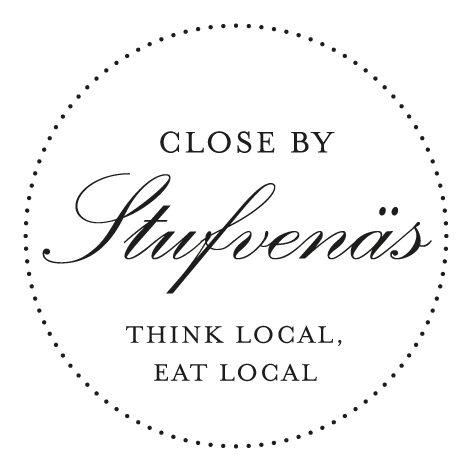På Stufvenäs Gästgifveris klassiska och smakfulla julbord försöker vi bevara de småländska och traditionella julbordsrätterna. Några av rätterna har anor långt bak i tiden men det finns också de som har en modernare historia.
Vi har skapat två olika kvalitetsmärkningar för att du som gäst ska få den bästa måltidsupplevelsen hos oss.
Låt dig väl smaka!
Made by Stufvenäs är vår egen kvalitetsmärkning som visar vilken mat som är tillagad från grunden, av noga utvalda råvaror, i vårt kök av vårt duktiga köksteam.

Close by Stufvenäs är vår kvalitetsmärkning av riktigt bra och noga utvalda lokalproducerade produkter och råvaror.
Julbrödet skiljde sig rejält från det brödet man åt till vardags. Framförallt genom att det bakades till formbröd. Dessutom användes vört till degvätska och hade man det riktigt gott ställt så stoppade man i torkade frukter såsom äpple, fikon och russin. Brödet smaksattes också med sirap, nejlika, kanel och kardemumma.
Nedräkningen inför julen kallas för dan före dopparedan. Under julförberedelserna var det praktiskt att i all hast doppa lite bröd i skinkspadet från julskinkan som ofta stod på spisen. Från början är dopp i grytan är inte en typisk julrätt utan något som man var tvungen att göra för att mjuka upp gammalt, hårt bröd så att det gick att ätas. Nästan som dagens fondue.
Julgröt var praktisk festmat när släkten skulle äta tillsammans. Gröt var inte bara en huvudrätt vid jul utan också vid slåtter- och skördegillen. Men förr åt man inte risgrynsgröt utan korngrynsgröt.
Vår tids inlagda sill härstammar från den salta sillen som man åt till vardags förr. Salt strömming stod på matbordet nästan varje dag i de småländska byarna förr. Det åt man betydligt oftare än kött. Så en uttjatad vardagsrätt har med hjälp av kryddor, sås och olika smaksättningar förvandlats till en delikatess i vår tid.
Den äldsta skandinaviska benämningen på julfirandet var att “dricka jul”. Julölet skulle vara av bästa kvalitet. Som en föregångare till vår tids julbordsätande på restaurang kan man se byaböndernas förjulsfest, då man gick runt i gårdarna och smakade på varandras julöl. Sen hembrygden upphörde har det uppstått olika blanddrycker som mumma. Den mest kända och älskade är Julmusten som lanserades 1910.
Glögg har funnits sedan medeltiden och skapades genom att man var tvungen att krydda vinet för att dölja dess dåliga kvalitet. Sedan värmde man det för att ta död på mögel och annat. Men det är först i slutet av 1800-talet som den nämns som en speciell juldryck. Nu för tiden är glögg en värmande åretruntdryck.
Hasselnötter och äpplen har lång tradition som julgodis i Småland. Exotiska frukter som fikon, dadlar, russin, utländska nötter och choklad- och marsipanfigurer kom när kolonialhandeln utvecklades under 1800-talet.
Att vi äter så mycket fläskmat på julen beror på att man under självhushållets tid inte åt annat än insaltat kött under det övriga året. Men vid höstens storslakt brukade man spara en eller ett par grisar som slaktades strax före jul och som avnjöts färskt och det ansågs som en stor delikatess. Julskinka hörde dock inte hemma på julbordet i bondesamhället. Skinkorna brukade sparas till sommaren och styckas till mindre bitar. Det mesta fläsket kokades förr i tiden och det feta spadet användes exempelvis till dopp i grytan. Julskinkan härstammar från slutet av 1600-talet, men åts då främst av de högre stånden.
Enligt vissa källor har rätten tillskrivits operasångaren Per Adolf “Pelle” Janzon på 1800-talet. Han gjorde sig känd för att bjuda på en sexa med öl, snaps och ansjovisgratäng, vilket skulle ha givit upphov till namnet Janzons frestelse på denna typ av gratäng. Han skulle ha inspirerats av ansjovislådor med snarlikt innehåll. Dock blev rättens namn inte allmänt accepterat förrän 40 år efter Janzons död, en bit in på 1900-talet.
Vår svenskaste nationalrätt. Men köttbullar finns över hela världen under olika namn och i olika smaker. Idag är det vanligast att vi steker våra köttbullar men under 1700- och 1800-talen så kokades de som frikadeller. Det är en ganska modern företeelse att mala kött till färs. Men riktigt finskuret kött till korv och annat är historiskt sätt en vanlig metod för att ta till vara på alla styckningsdetaljer och för att underlätta för människors dåliga tandhälsa.
Lutfisken kallad stockfisk och var en julrätt i många småländska hem. Färsk fisk var svårt att få tag på under vintern. Förr åts lutfisken som torrfisk. Man skar tunna skivor som bultades för att bli mer lättuggade och doppades i smör.
Källa: Smaken av östra Småland & Öland, Nationalencyklopedin, Nordiska museet